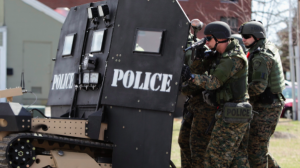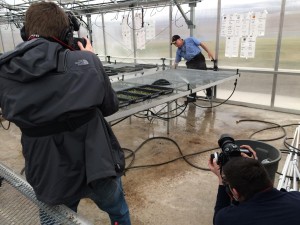A team of BYU professors, BYU students and a BYU alumnus have made a documentary film about a former police officer who created Utah’s first S.W.A.T. team is now investigating it for police brutality.
The film, titled “Peace Officer,” was accepted into this year’s South by Southwest Film Festival in Austin, Texas. The main subject of the film is William “Dub” Lawrence, a former Davis County sheriff, former deputy for Bountiful City Police Department and former U.S. Marine, who created and trained the first S.W.A.T. team in Utah in the 1970s.
The premise for the story came to co-director Scott Christopherson after Lawrence approached him following a softball game. Lawrence asked for technical help with compiled footage he obtained from Freedom of Information and GRAMA requests, which enable journalists and the public to obtain inside government information. Lawrence was using the footage to make a short video of evidence.

Christopherson soon learned that Lawrence’s interest in the footage over the past two-and-a-half years was motivated by his desire to uncover clues surrounding the death of his 36-year-old son-in-law, Brian Wood in 2008. Wood was fatally shot by the same S.W.A.T. team his own father-in-law had founded and trained after a 12-hour standoff outside his home in Farmington.
During filming, the movie crew said they did not know how much national conversation would build around the now-heated topic of police action.
“We started this two and a half years ago,” Christopherson said. “When we started making the film we couldn’t have anticipated that Ferguson would happen or that Eric Garner would happen and there would be such a national outcry about this issue.”
When directors Brad Barber and Scott Christopherson first started filming, they only knew about police militarization in Utah.
“We saw it happening in Utah and thought, well if it’s happening here it’s probably happening everywhere,” Christopherson said. “Ferguson just kind of confirmed that for us.”

According to Christopherson, the film follows Dub on his obsessive exploration in investigating the death of his son-in-law and confronting the S.W.A.T. team he founded. He has been investigating the crime scene evidence and footage for seven years.
Christopherson said according to police reports, Wood possessed a gun, which he held to his head. The 12-hour standoff between him and the S.W.A.T. team ended when he pointed the gun at police officers, and they fired the fatal shot.
Dub disagreed. He said Wood had been stunned with a taser and lay non-responsive on the ground when the S.W.A.T. team shot him.
Barber and Christopherson were inspired to make “Peace Officer” to share Lawrence’s story, uncover other police-involved shootings in their communities and increase awareness of police militarization in Utah.

Barber is a current BYU film professor and alumnus of the media arts program. Graduating in 2001, Barber later went on to receive an MFA from the University of Southern California’s Cinema Television Production program.
Barber’s right-hand man and co-director on the film, Christopherson, is also a BYU media arts alumnus from 2008. Barber and Christopherson were acquaintances before they conceived the idea for the film.
Barber said he has a passion for documentary film because it mixes real life with art.
“It’s a way we can learn about other people that are different from us,” Barber said. “It helps us empathize with other people, and we will ultimately become better disciples.”
Barber said being LDS influences his work in film and in the classroom.
“I don’t immediately look for LDS subjects or LDS stories specifically, but of course it influences the decisions I make,” Barber said. “Specifically the biggest influence is the Holy Ghost. I talk to my students about this a lot — I regularly pray about the films I’m working on.”
Barber said the Holy Ghost has the biggest influence on his work in documentary film.
“Especially with documentary, it’s kind of a delicate thing to represent someone else’s story in your own voice,” Barber said. “It’s something to be really careful about and pray for the Holy Ghost to do it appropriately.”
Christopherson and Barber brought on a few BYU film students to be a part of the crew.
One of the students, Jared Jankins, is a senior studying media arts. He worked on this film and credits crew with inspiring him to continue documentary film.
“The people I worked with have inspired me to pursue documentary even more,” Jankins said.
Being a former BYU film student himself, Christopherson had a few words of advice for current film majors or aspiring filmmakers.
“Be open to other people suggesting ideas to you, no matter how unusual they seem,” Christopherson said. “Even if you don’t find success early on in the film world, it takes a lot of patience and work ethic to eventually find success.”
There will be a total of three screenings for the film at the SXSW Film Festival in Austin, Texas, on March 15, 16 and 20.




